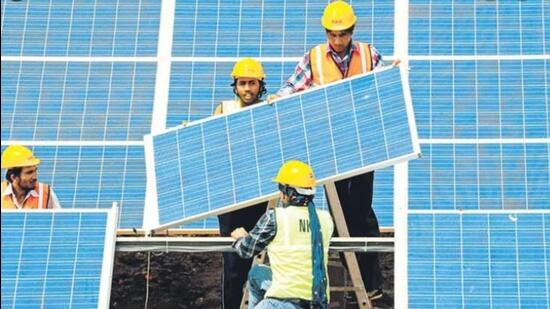Guest Column| India’s march towards a de-carbonised future
For India, energy transition will be the most important pillar for climate action and for this we are crafting a robust ecosystem to enable the transformation through technology readiness, capacity upgrade, climate finance
India is a torch-bearer for curbing greenhouse gas effects and has stringent norms in place for carbon, sulphur dioxide and particles of mercury emissions. The nation’s commitment to the world community is strengthened by Prime Minister Narendra Modi’s announcement in the COP26, namely Panchamrit, that is raising India’s non-fossil fuel-based energy production to 500 Giga Watt (GW) and meeting 50% of the country’s energy requirement through renewable sources by 2030. With this, carbon intensity will be reduced by 45% and projected carbon emission will be cut by 1 billion tonnes by 2030 from 2021 levels. Hence, India is committed to becoming carbon neutral by 2070 i.e. net zero emission.

The UN emission gap report 2020 has concluded that India is well on its way of achieving nationally determined contribution (NDC) targets with its policies. Very few countries have this stellar achievement, which has been spearheaded by Modi. India plans to reduce the emission intensity of GDP by 33% to 35% by 2030 from 2005 levels and has to create an additional carbon sink of 2.5 to 3 billion tonnes besides achieving about 50% of cumulative electric power installed capacity from non-fossil fuel energy resources by 2030. The achievement is that the emission intensity has reduced by 24% between 2005 and 16 (27% by 2020). Forest and tree cover has increased between the 2015 and 19. The annual increase in carbon stock between 2015 and 17 has been 19.5 million tonnes, which is 71.5 million tonnes of CO2 equivalent. The total carbon stock in forest was estimated at 26.24 Mt CO2, showing an increase of 156.2 Mt CO2 as compared to the last assessment in 2017.
The Climate Action Tracker too states that India is the only G20 country whose NDCs are 2°C compliant. The target is to achieve about 40% cumulative electric power installed capacity from non-fossil fuel energy resources by 2030. The achievement is that by August 2021, the share of non-fossil sources in installed capacity of electricity generation was 39.2%, including hydro and nuclear. Solar energy increased from 2.63 GW in March 2014 to 50.78 GW in August 2021. Wind energy was 40.13 GW on August 21, 2021. Total RE was 152.90 GW (solar, wind, biomass, small hydro) on August 21, 2021.
India’s ambitious initiatives for climate action are 450 GW renewable targets, land degradation neutrality, National Hydrogen Mission, self-reliance in energy production by 2047, 100% electrification of Indian Railways by 2024/net zero by 2030, 20% ethanol blending target advanced to 2025, 5,000 compressed bio-gas plants, FAME-2 scheme launched in 2019 and promoting a circular economy in key sectors.
Green Hydrogen Policy the gamechanger
In pursuance of its professed objective, India is actively promoting electric vehicles and renewable energy electric vehicle charging stations. Additionally, to address the intermittent/infirm nature of wind and solar power generation, electricity storage systems, at an affordable cost, including pump storage hydro power plant, are under active implementation.
The gamechanger that India has identified, for de-carbonation, is by way of Green Hydrogen Policy to reduce global warming to levels less than 2 degrees centigrade and cap it at pre-industrialisation levels of 1.5 degrees centigrade. To promote green hydrogen (and green ammonia), all inter-state transmission charges have been waived for 25 years for the projects commissioned before June 30, 2025. Banking of such power with the distribution companies has been permitted without any restrictions and banked renewable power (say wind, solar, biomass etc) can be used for green hydrogen.
Given the commitment to sustainability, FinTech (finance and technology) both from within the country and by way of foreign direct investment (FDI) is of crucial importance, including large-scale deployment of renewable asset management software tools and artificial intelligence.
Making India energy independent
Modi has encouraged an investor-friendly policy in infrastructure, including the power sector. The energy transition from pre-dominantly coal-fired electricity generation to hydro power as well as non-fossil fuel power would itself create the requirements for stepping up investments in generation and transmission of power and added employment. India’s contribution to global carbon emissions is low. India has actually utilised just 1.3% of total carbon space and India’s utilisation in terms of per capita global carbon space would be about 17.5% logically 700 GT at 2-degree centigrade warming.
The tariffs for generation, transmission and distribution of electricity in India are regulated by the power sector regulators at the central (for projects involving more than one state) and state electricity regulators. The entire exercise is conducted by regulators in a transparent manner and as per rules in the public domain. The government has announced that we will be using solar to split water by electrolysis to produce green hydrogen to make India energy independent. This is, however, a Herculean endeavour.
The world community has shown faith in the Indian economy and Modi’s resolve. India has a well-established and independent regulatory framework with vibrant and dependable capital markets, a robust banking system, skilled work force and a large consumer base. Hence, the Indian economy, given its inherent resilience and robustness, will continue to soar. India has judiciously put to use available tools to avoid major losses of key assets during the Covid-19 pandemic.
For India, energy transition will be the most important pillar for climate action for the country and for this we are rapidly crafting a robust ecosystem to enable the transformation through technology readiness, capacity upgrade, climate finance, regulatory reforms and new and innovative business models, which will together help in achieving India’s climate and sustainable development goals, as also the Prime Minister’s vision of a solar alliance of nations. rpachnanda@hotmail.com

The writer is chairman of Haryana Electricity Regulatory Commission. Views expressed are personal



